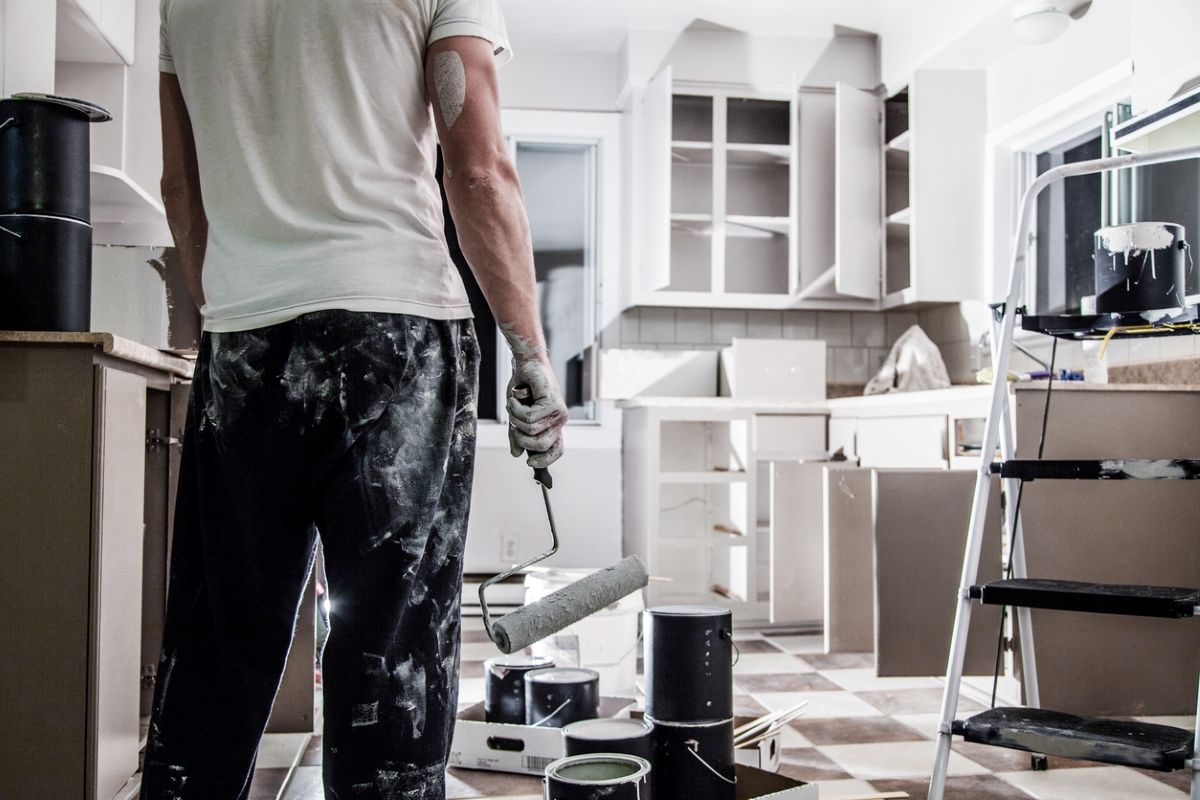

We may earn revenue from the products available on this page and participate in affiliate programs. Learn More ›
Is your kitchen looking a little worse for wear? Instead of committing to the expense of replacing rundown kitchen cabinets, consider the more cost-effective solution of repainting them. Repainting laminate cabinets is an affordable way to turn eyesore storage into eye-catching, modern cabinetry. While you may already know how to paint furniture, doors, and cabinetry that are made of wood, painting laminate is another beast altogether.
Laminate is not nearly as porous as its wood equivalents. To get professional-looking results, first and foremost, you’ll have to use a specific paint for laminate cabinets. The methods for preparing and painting laminate cabinets are also different than they are for wood. Follow these best practices to update your cabinetry with a fresh face that will last for years.
Tools & Materials
Bobvila.com may earn a commission from purchases made through these links.
Project Overview
Working Time: 15 to 30 hours
Total Time: One week
Skill Level: Intermediate
Estimated Cost: $200 to $400
How to Paint Laminate Cabinets
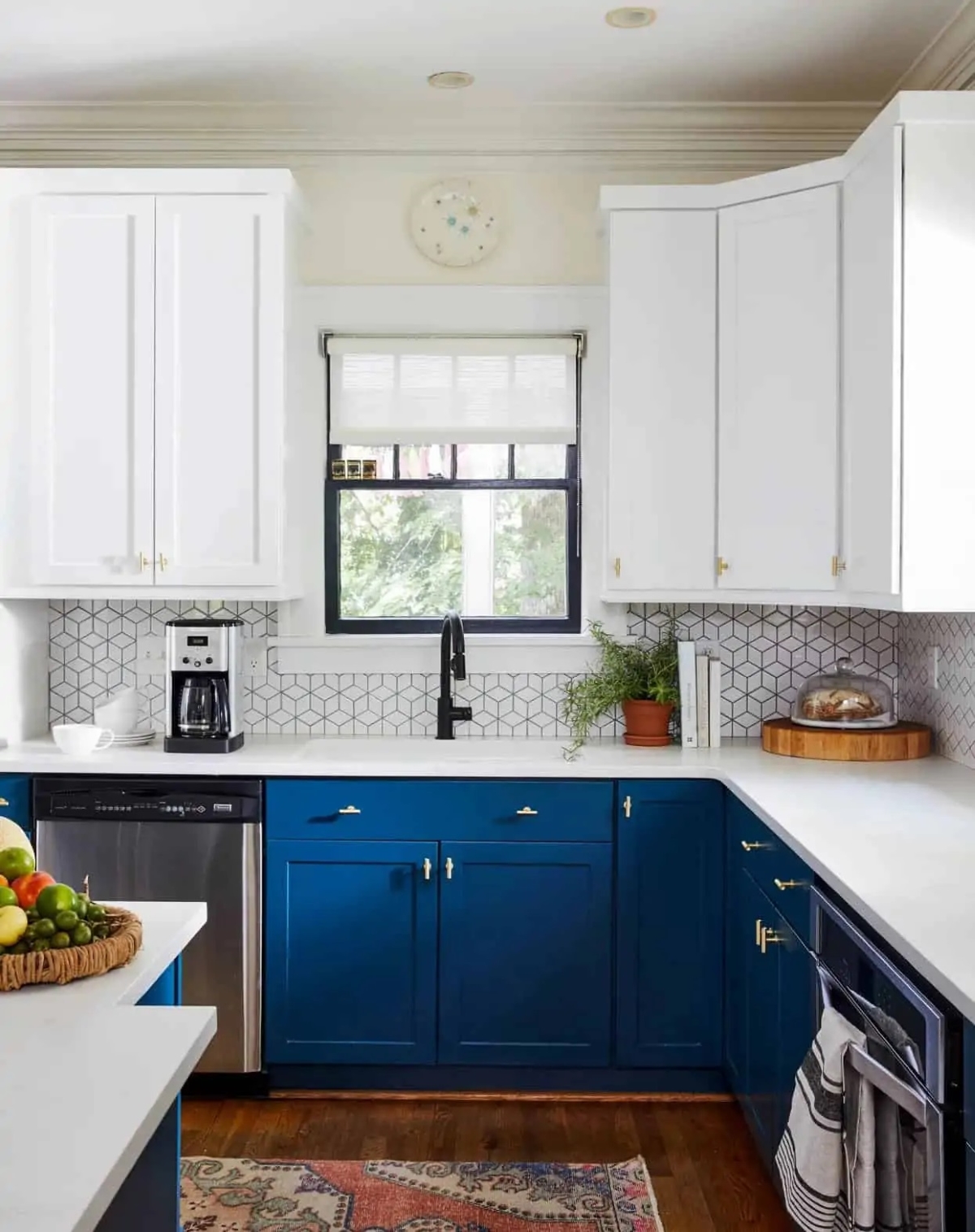
When painting over laminate cabinets, the first thing you have to do is choose a quality paint. The right type of paint will leave a chip-resistant finish that’s easy to clean with a damp cloth or sponge. Paint with a satin finish will yield the best results because it will help hide the cabinets’ imperfections.
Painting laminate surfaces also requires a few extra steps and careful preparation. Make sure to read all of the steps below before starting this project.
- Lay a drop cloth over floors and other surfaces you want to protect.
- Prepare the cabinets for paint by removing all door hardware and hinges.
- Inspect the cabinet doors for damage and make any necessary repairs. Lightly sand the cabinets using 120-grit sandpaper. Sanding will roughen the surface, helping the paint adhere to the smooth surface of the laminate. Don’t sand too much or you could pierce the laminate surface, damaging the cabinets. (If you want to avoid sanding, you can also use a deglosser, which removes grease while acting like a liquid sander.)
- After you’re done sanding, remove dust using a shop vac or tack cloth.
- Prime the cabinets using high-quality paint brushes and primer, making sure to stir the primer thoroughly before applying it. If you want to eliminate brush stroke marks, use a roller instead of a paintbrush on the flat surfaces of the cabinet.
- Using 100- to 120-grit sandpaper, lightly sand the primer so it better adheres to the paint. Remove any dust with a tack cloth or shop vac.
- Stir the paint thoroughly, then apply a small amount to an inconspicuous spot on a cabinet to make sure it adheres to the surface properly. If it’s not bubbling, begin applying the first coat using a high-quality paint brush or roller.
- Sand the first coat lightly after it dries, then apply a second coat. Allow the paint to cure for a full week before reinstalling the hardware and subjecting the cabinets to normal use to avoid scratching the new finish.
RELATED: The Best Paint Rollers and Covers, Tested and Reviewed
Painting Laminate Cabinets: Dos and Don’ts for Getting the Job Done

There are many missteps that can ruin a laminate cabinet painting project, including failing to remove the hardware before painting to using the wrong primer. Review these tips to ensure you end up with a professional-looking paint job.
Don’t paint over damaged laminate.
If laminate is cracked, warped, or peeling, paint may not bond to the cabinets properly. Before painting, ensure that the laminate is in good condition by repairing minor laminate damage or refacing the cabinets.
Do remove cabinet hardware.
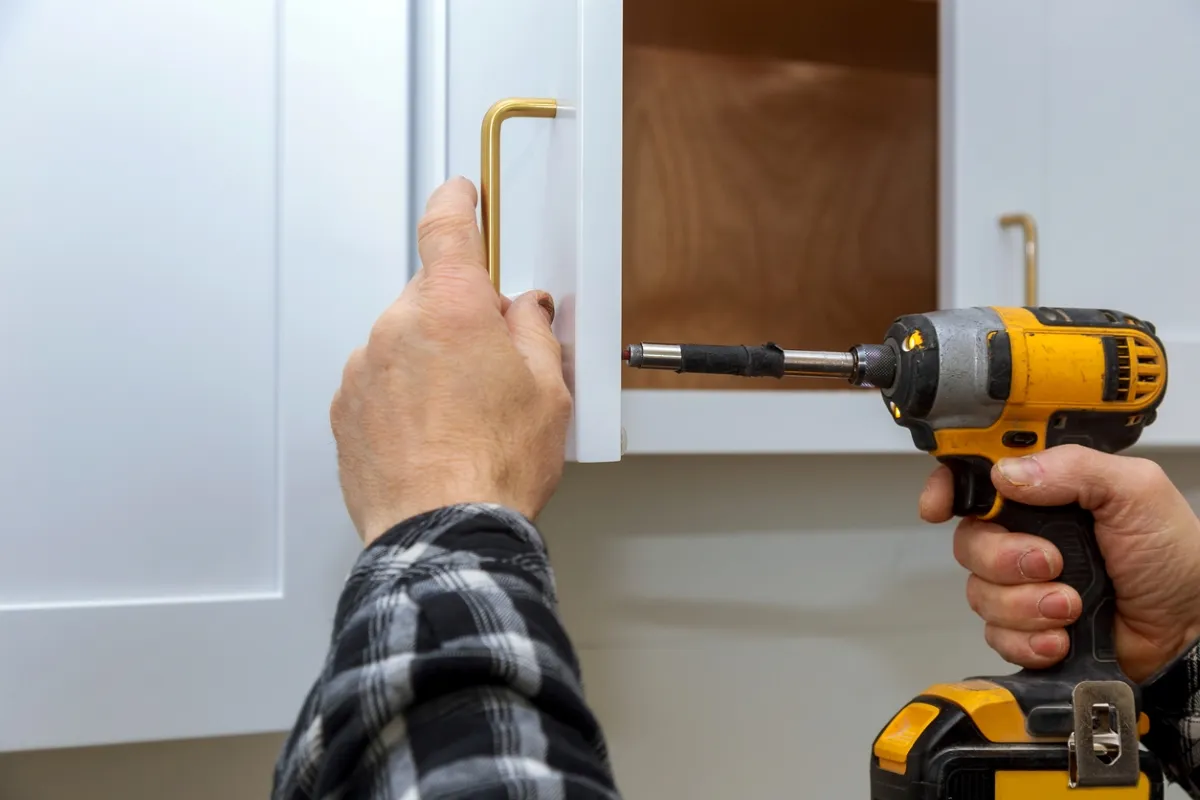
To get the smoothest application of paint, you first need to remove all obstructions in your way. Remove knobs, pulls, and other visible cabinet hardware before painting laminate cabinets. If the cabinet hinges are visible and removable, take the doors off the cabinets and paint them over a workbench or sawhorse. If you choose to paint the doors in place, cover metal hinges with painter’s tape.
Don’t leave dirt and grit behind.
Before you paint laminate cabinets, use trisodium phosphate to wipe away grime. Rinse the cabinets with water and allow them to dry completely. Don’t skip this step because you think the cabinets look clean-ish; the paint won’t adhere to the laminate if the surface is dirty.
Do sand the cabinets.
To create a strong bond between the paint and your cabinet, roughen up the slick laminate with the help of a gritty companion: sandpaper. Thoroughly scuff the surfaces of the cabinet with 120-grit sandpaper—enough to get a dusting, but not so much that you tear through the paper-thin laminate surface. Clean up any dusty remains with a handheld vacuum and a damp cloth.
If you plan on sanding several cabinets, consider upgrading from sandpaper to a motorized orbital sander. Your upper body will thank you.
Don’t use just any old primer or paint.
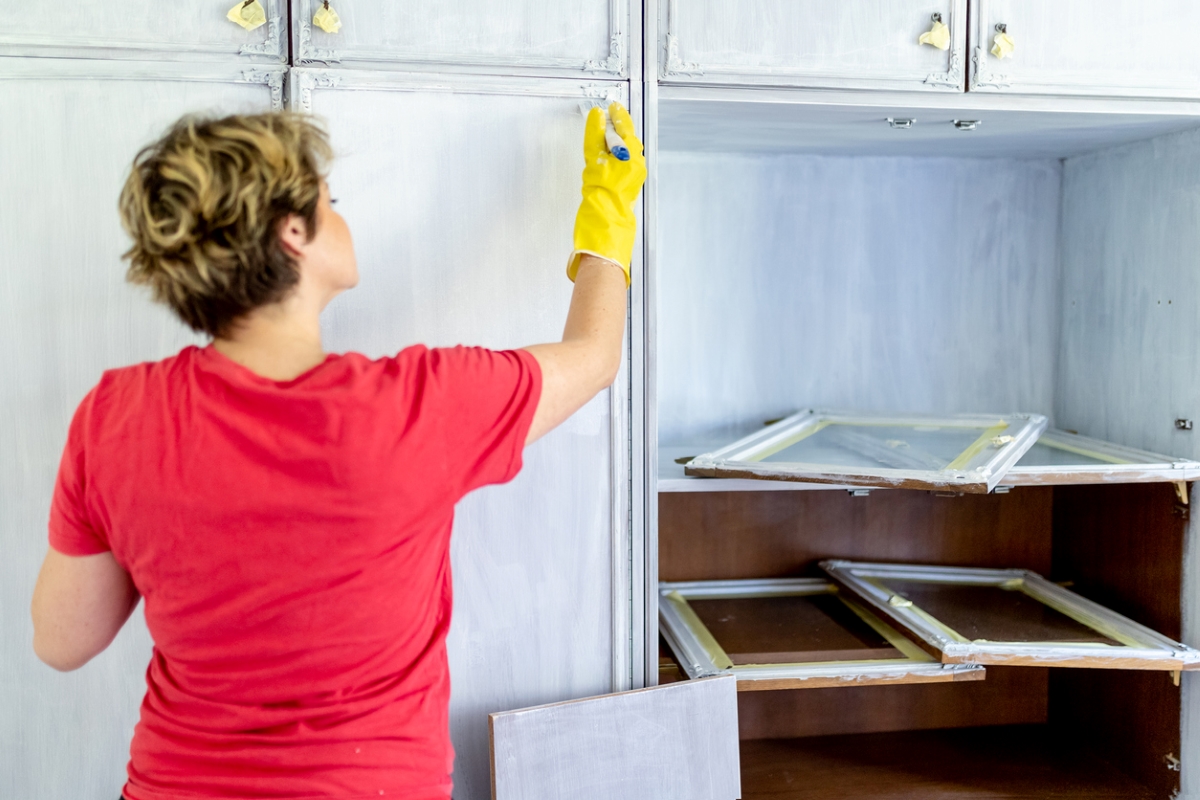
Laminate doesn’t play well with all primers and paints, only those specially formulated to adhere to its picky surface. If you opt for a primer, choose a bonding primer that’s tenacious enough to stick to laminate, like Zinsser Interior Primer, and then top it with an oil- or latex-based paint after the primer has cured.
If you select a paint that can be applied directly over laminate, like Behr Premium semi-gloss cabinet paint, you can skip the primer—just know that your choice of colors will be limited.
RELATED: How to Paint Laminate Countertops
Do test your paint first.
Paint in hand, you’re almost ready to get to work. Before you begin, first test the paint’s bonding capabilities. This step could save you from a case of peeling paint down the road, and the need to redo hours of work.
Apply a swath of paint to a small, inconspicuous area of the cabinet (like the back of a door you seldom open), let it cure, then inspect the bonding. If you see bubbles in the coat, the paint is not adhering well. Consult a paint pro at a paint or home improvement store to identify a more suitable product for the job.
Don’t leave brush strokes behind.
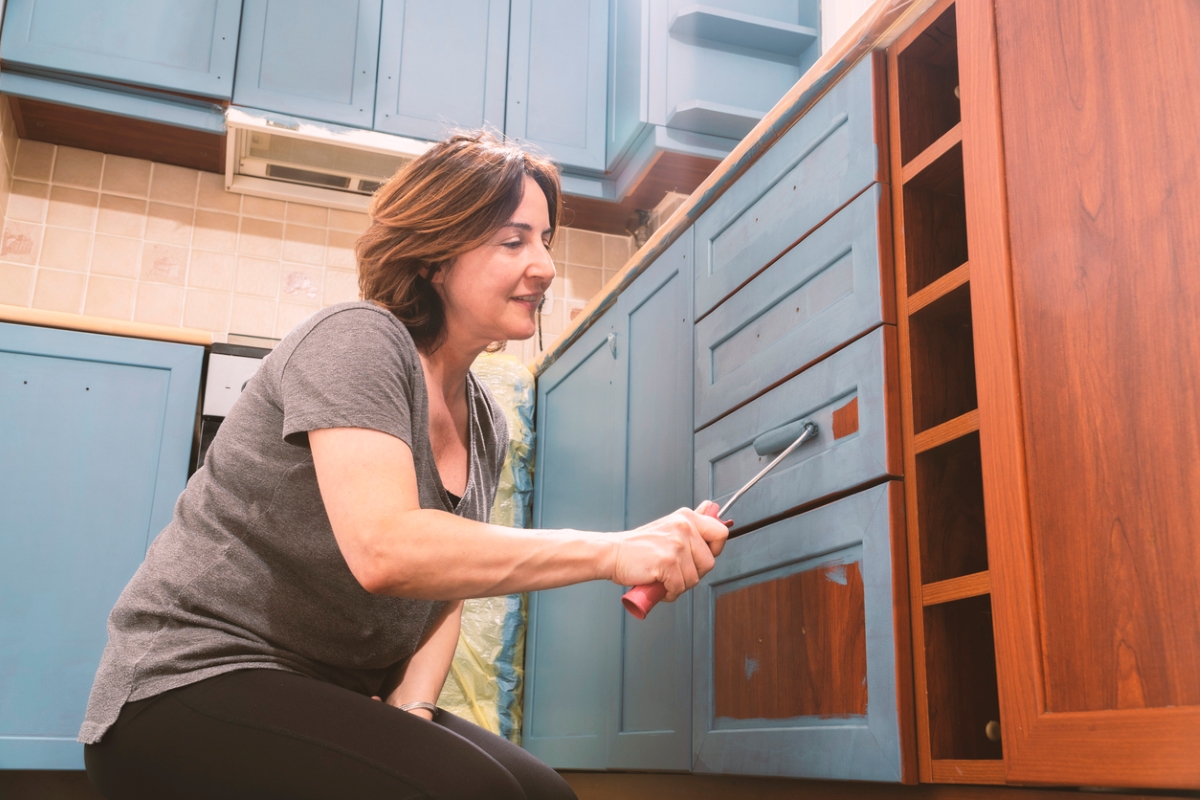
Paint brushes tend to leave brush strokes in their wake. For a streak-free finish on flat laminate cabinet surfaces, opt instead for a roller, sprayer, or a paint pad.
Do minimize your exposure to fumes.
Primers and paints release dangerous fumes, which is why it’s important to increase ventilation in the room as you’re working. Keep children and pets out of the space too. We also recommend pulling on a pair of chemical-resistant work gloves before you go off to paint the town—or perhaps in this case, your cabinets—red!
FAQs
Ahead, learn how to determine if your cabinets are laminate or real wood, and discover out how much you can expect to spend on this project.
Q: How do I tell if I have laminate cabinets?
There are a few ways you can check to see if your cabinets are laminate: Look at the edges of the cabinet doors. If they’re smooth, they’re likely laminate. You can also run your hands over the surface of the cabinets. Real wood will usually be rough, while laminate cabinets will have a very smooth finish.
Q: Do I need to use primer when painting laminate?
Primer is essential when painting laminate cabinets. If you fail to prime them, the paint will almost certainly begin peeling off as soon as you put the cabinets back into service. For best results, use a quality binding primer, such as Zinsser B-I-N primer and sealer.
Q: When painting laminate, do I actually have to sand the cabinets?
If you absolutely hate sanding, you don’t have to sand the cabinets. However, the primer and paint will better adhere to the cabinets, and you’ll get a smoother finish if you do. An alternative to sanding is to use a good deglosser, which acts as a liquid sander.
Q: How much does it cost to hire a professional to paint your cabinets?
If you want to hire a professional to paint your kitchen cabinets, expect to pay $400 to $1,300 for the job, depending on the amount of cabinetry you have and the market you live in. If you plan on painting the cabinets yourself, expect to pay $35 and $80 per gallon of paint and another $100 or so in supplies.
Final Thoughts
By following the above methods, you can give your old bathroom or kitchen cabinets a fresh look, saving hundreds or even thousands over the cost of replacing them. Do keep in mind that while painting kitchen cabinets isn’t a difficult task, it is important to use the right primer and paint along with the proper techniques to achieve good and long-lasting results. Patience is key when painting laminate cabinets, as this is a time-consuming project that typically requires multiple days to complete.
